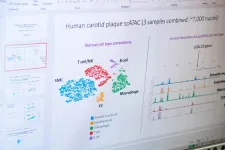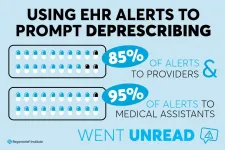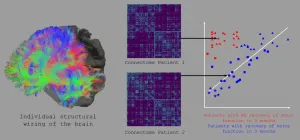(Press-News.org) ANN ARBOR, Mich. - The number of adolescents admitted to the hospital for severe illness from eating disorders has increased significantly during the COVID-19 pandemic, new research suggests.
At one center, the number of hospital admissions among adolescents with eating disorders more than doubled during the first 12 months of the pandemic, according to the study that appears in a pre-publication of Pediatrics.
The 125 hospitalizations among patients ages 10-23 at Michigan Medicine in those 12 months reflect a significant increase over previous years, as admissions related to eating disorders during the same timeframe between 2017 and 2019 averaged 56 per year.
"These findings emphasize how profoundly the pandemic has affected young people, who experienced school closures, cancelled extracurricular activities, and social isolation. Their entire worlds were turned upside down overnight," said lead author Alana Otto, M.D., M.P.H., an adolescent medicine physician at University of Michigan Health C.S. Mott Children's Hospital.
"For adolescents with eating disorders and those at risk for eating disorders, these significant disruptions may have worsened or triggered symptoms."
Findings may be the tip of the iceberg
But the numbers may represent only a fraction of those with eating disorders affected by the pandemic, researchers said, as they only included young people whose severe illness led to hospitalization.
"Our study suggests that the negative mental health effects of the pandemic could be particularly profound among adolescents with eating disorders," Otto said. "But our data doesn't capture the entire picture. These could be really conservative estimates."
The study also suggests the rate of admissions at the institution steadily increased over time during the first year of the pandemic. The highest rates of admissions per month occurred between nine and 12 months after the pandemic began, with rates continuing to climb when the study period ended in March 2021.
Restrictive eating disorders include anorexia nervosa and may be marked by dietary restriction, excessive exercise, and/or or purging to lose weight.
Genetics, psychological factors, and social influences have all been linked to developing eating disorders and adolescents with low self-esteem or depressive symptoms are at especially high risk.
Changes to adolescents' day-to-day lives during the pandemic, such as school closures and cancellation of organized sports, may also disrupt routines related to eating and exercise, and be an impetus for developing unhealthy eating behaviors among those already at risk, Otto said.
"A stressful event may lead to the development of symptoms in a young person at risk for eating disorders," she said.
"During the pandemic, the absence of routine, disruptions in daily activities and a sense of a loss of control are all possible contributing factors. For many adolescents, when everything feels out of control, the one thing they feel they can control is their eating."
Some patients also reported that limitations in playing sports and other physical activities made them worry about gaining weight, leading to unhealthy dieting or exercise. Increased social media use during the pandemic may also expose young people to more negative messaging about body image and weight.
There could be indirect connections to the pandemic as well, Otto said. For example, an adolescent with significant eating disorder symptoms and severe malnutrition may have only come to medical attention when they moved back in with their parents after their college closed unexpectedly during the shutdowns.
Increased demand but limited access to care
Another potential factor may be delayed care for non-COVID-19 conditions, including eating disorders, and fewer in-person visits as part of measures to reduce transmission risks, authors noted.
Adolescents with eating disorders may be particularly impacted by reduced availability of in-person care, Otto said. Assessment and management of patients with malnutrition generally requires measuring weight and vital signs and may involve a full physical examination or lab tests.
Confidentiality, a critical component of clinical care for adolescents, may also be limited in virtual settings.
While the study is limited by its small sample size, it comes as international reports indicate increases in both outpatient referrals to child and adolescent eating disorder services and inpatient admissions related to anorexia nervosa among adolescents, Otto said.
"Although our findings reflect the experience of a single institution, they're in line with emerging reports of the pandemic's potential to have profound negative effects on the mental and physical health of adolescents across the globe," Otto said.
"Adolescents may be particularly vulnerable to negative effects of societal upheaval related to the pandemic and to developing eating disorders during the COVID-19 era. Providers who care for adolescents and teens should be attuned to these risks and monitor patients for signs and symptoms of an eating disorder."
Patient demographics were similar before and during the pandemic, according to the study. But patients admitted during the COVID-19 pandemic were less likely than those admitted prior to the pandemic to have public insurance, something that should be studied further, authors said.
Otto noted that for adolescents with eating disorders, medical admission is often the beginning, not the end, of treatment, which can be a long journey. Among the biggest barriers to care are a shortage of qualified providers and insurance coverage gaps.
"Access to care was already limited before the pandemic and now we're seeing an increased demand for these services. As we see a wave of young people coming to the hospital for urgent medical concerns related to eating disorders, we need to be prepared to continue to care for them after they leave the hospital," Otto said.
"I'm hopeful that as adolescents are able to go back to school and engage with friends and activities that are meaningful to them, we will see admissions decrease," she added. "But it takes time for these symptoms to develop and eating disorders generally last for months or years.
"We expect to see downstream effects of the pandemic on adolescents and young people for some time."
INFORMATION:
Study Cited: "Medical Admissions Among Adolescents With Eating Disorders During the COVID-19 Pandemic," Pediatrics, DOI: 10.1542/peds.2021-052201
Using single cell technology, a new study sheds light on the significance of genetic risk factors for, and the diversity of cells involved in, the development of coronary artery disease. The researchers analysed human atherosclerotic lesions to map the chromatin accessibility of more than 7,000 cells. The chromatin accessibility is known to reflect active regions and genes in the genome. The findings were published in Circulation Research.
Genome-wide association studies of the human genome have identified over 200 loci associated with coronary artery disease. More than 90% of them ...
If you've watched Netflix, shopped online, or run your robot vacuum cleaner, you've interacted with artificial intelligence, AI. AI is what allows computers to comb through an enormous amount of data to detect patterns or solve problems. The European Union says AI is set to be a "defining future technology."
And yet, as much as AI is already interwoven into our everyday lives, there's one area of the globe where AI and its applications are in their infancy, says Ekaterina Kim, an associate professor at the Norwegian University of Science and Technology's (NTNU) Department of Marine Technology. That area is the Arctic, an area where she has specialized in studying sea ice, among other topics.
"It's used a lot in marketing, in medicine, but ...
BINGHAMTON, N.Y. -- A million years ago, dry seasons became more frequent and forests retreated before the encroaching savanna. Meanwhile, clustered around a nearby lake, our ancient ancestors fashioned stone tools.
During the long press of years, mud and sediment in that East African lake turned to stone, trapping pollen and microscopic organisms in its lattice. Today, researchers like Kennie Leet analyze samples of these ancient sediments, known as sediment cores, to create a picture of the environment early humans called home.
A doctoral student in geological sciences, Leet is the first author ...
Researchers from University of Mannheim published a new paper in the Journal of Marketing that examines the effect of wage inequality on customer satisfaction and firm performance.
The study, forthcoming in the Journal of Marketing, is titled "Wage Inequality: Its Impact on Customer Satisfaction and Firm Performance" and is authored by Boas Bamberger, Christian Homburg, and Dominik M. Wielgos.
Irrespective of wage cuts and employee layoffs, the wages of top managers rose to record levels during the pandemic and wage inequality continues to grow worldwide. However, according to a 2015 OECD report, "wage inequality is harmful to long-term economic growth and undermines ...
The door has finally opened on screening newborn babies for pyridoxine-dependent epilepsy (PDE), a severe inherited metabolic disorder. This screening promises to enable better and earlier treatment of the disease. To identify new biomarkers that can be used in the newborn screening protocol, also known as the neonatal heel prick, researchers at the Radboud University Medical Center joined forces with scientists at the Radboud University's FELIX laser laboratory. They published their findings in The Journal of Clinical Investigation.
The discovery and identification ...
PULLMAN, Wash. - Even before the pandemic made Zoom ubiquitous, Washington State University researchers were using the video conferencing app to research a type of cannabis that is understudied: the kind people actually use.
For the study, published in Scientific Reports, researchers observed cannabis users over Zoom as they smoked high-potency cannabis flower or vaped concentrates they purchased themselves from cannabis dispensaries in Washington state, where recreational cannabis use is legal. They then gave the subjects a series of cognitive tests.
The researchers found no impact on the users' performance on decision-making tests in comparison to a sober control group but did find some memory impairments related to free ...
INDIANAPOLIS -- The vast majority of electronic health record (EHR) alerts attempting to reduce the prescribing of high-risk medications linked to dementia in older adults went unread in a study led by research scientists from Regenstrief Institute, Purdue University and Indiana University School of Medicine. The goal of the intervention was to facilitate the deprescribing of anticholinergics through both provider and patient-based alerts, however, engagement with the alerts was so low, the study team was unable to conclude if this approach could be ...
When blood flow to the brain is somehow reduced or restricted, a person can suffer what we know as a stroke (from "ischemic stroke" in medical jargon). Stroke is one of those conditions that seems fairly common. This isn't a misperception: just in Europe, there are over 1.5 million new cases each year.
Some strokes can be lethal, and when they're not they often result in serious damage to the victim's ability to move. In fact, stroke is one of the major causes of long-term disability today. Recovery can be a long and arduous road. Again, in Europe, under 15% of the patients ...
Software to help towns and cities use street-planting to reduce citizens' exposure to air pollution has been developed by researchers at the University of Birmingham.
Street planting, or 'green infrastructure', is an essential part of the urban realm, but there is a misconception that plants remove or 'soak up' a lot of pollution. Instead, planting at this scale primarily serves to redistribute pollution by changing air currents within streets and beside open roads.
Because of this, not only the position and amount of planting within a street, but also ...
Astronomers have designed and trained a computer program which can classify tens of thousands of galaxies in just a few seconds, a task that usually takes months to accomplish.
In research published today, astrophysicists from Australia have used machine learning to speed up a process that is often done manually by astronomers and citizen scientists around the world.
"Galaxies come in different shapes and sizes" said lead author Mitchell Cavanagh, a PhD candidate based at The University of Western Australia node of the International Centre for Radio Astronomy Research (ICRAR).
"Classifying the shapes of galaxies is an important step in understanding their formation and evolution, and can even shed light on the nature of the Universe itself."
Mr Cavanagh said that ...




